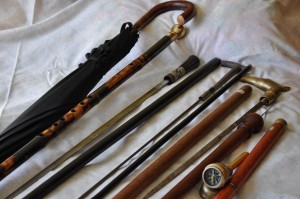Dual Purpose
Sword stick and cane-sword:
A sword stick or cane-sword is a cane incorporating a concealed blade. The term is typically used to describe European weapons from around the 18th century, but similar devices have been used throughout history, notably the Japanese shikomizue and the Ancient Roman dolon.
The swordstick was a popular fashion accessory for the wealthy during the 18th and 19th centuries. While the weapon’s origins are unknown, it is apparent that the cane-sword’s popularity peaked when decorative swords were steadily being replaced by canes as a result of the rising popularity of firearms, and the lessening influence of swords and other small arms.
Weapons Canes
Weapons canes present the more sinister side of the system cane and often carry the highest price tags. They are among the most complex of canes as they were skillfully crafted to conceal a host of deadly weapons.
Seemingly innocuous and plain in demeanor with little embellishment, these canes could, at the flick of the wrist, become a lethal weapon. So deceptive were these weapon canes, the French government declared it illegal to carry a cane into a public gathering for fear that any one of them might conceal harmful weapons, including guns.
These fears were apparently well founded. Three of the most diabolical canes known to exist were used by insurgents during 19th- century street riots in France. One such cane patented in 1883 and aptly named “La Terrible” contained three sets of double razor blades that emerged from its painted metal shaft ripping the hands of anyone trying to grab it. This cane along with two similarly outfitted canes, “La Diabolique,” and “La Redoutable” were so sinister they were outlawed in France shortly after they went into production.
As a rule, most gentleman of the 19th century owned a wide variety of
canes. That collection would most assuredly have included at least one sword, dagger or stiletto cane. Sword canes are, as the name suggests, long blades hidden in the shaft of a cane. The primary value of these sticks more than likely is derived from the blade as opposed to the cane itself. High quality blades by Toledo in Spain or Wilkinson from England carry a premium over other blades of less renowned manufacture, and likewise, Toledo blades with special etching or spring-action handles will bring a higher price than plainer models.
Soon after their introduction, other “gadget canes” became popular. Instead of a blade, these would hold the tools of one’s trade, compasses, umbrella’s and even flasks for keeping alcohol. Also known as a whiskey flask cane, these handy types of sticks were made famous by the renowned painter Toulouse Lautrec whose penchant for drink led him to the desperate measuring of hiding illegal absinthe in a flask ingeniously fitted into the shaft of his cane.
The most important rule of thumb when collecting system canes is to acquire only those canes whose contents are complete.
